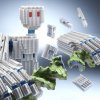Researchers at the Technische Universität München (TUM) developed a new tool in the ever expanding field of DNA origami. TUM Professor Henrik Dietz and his lab have developed a new way to “glue” DNA nanostructures together. Until now, DNA nanostructures have been created using the idea of “base-pairings,” in which nucleotides come together with their complementary nucleotides to form an almost unbreakable bond, and thus folding DNA strands into specific shapes. However, with this approach, you can’t design very complex dynamic structures. Now, the TUM group has taken inspiration from the natural process of combining complementary shapes of RNAse and transfer RNA. They designed the folded pieces of DNA so that it would have complementary geometries that could then be “snapped” into place. By altering the interaction strengths between the DNA building blocks, Dietz and his lab have allowed for a greater flexibility when designing 3D DNA nanostructures such as switchable gears, a tiny “book” that opens and closes, and even an actuator.
In fact, the researchers have used transmission electron micrographs to image a three-dimensional humanoid nanorobot to confirm that their technique had worked in putting the pieces together. Furthermore, with this new technique, adjusting the temperature can actually change the configurations of the nanostructures without any degradation. Previously, raising and lowering the temperature would cause separating and re-joining of base pairs which would ultimately wear out the system.
source:Technische Universität München
Nature Inspired Approach Towards DNA Origami Allows for Complex Nanobots

